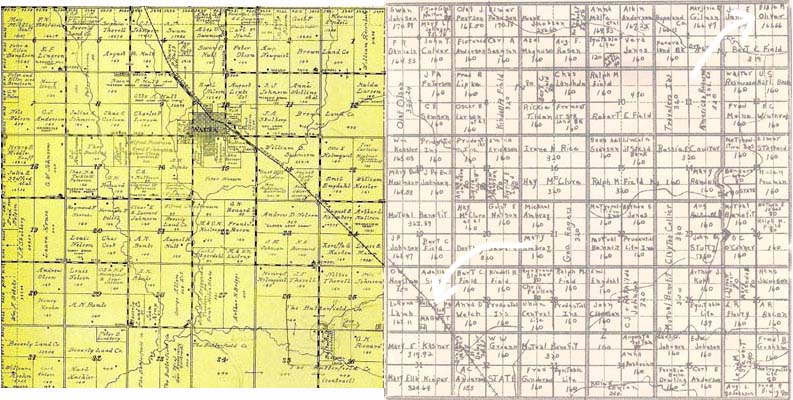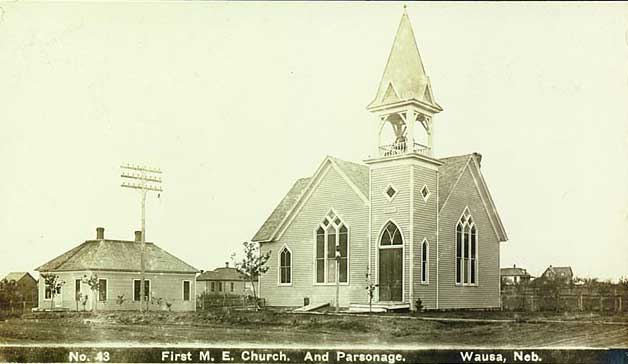Searching the records of Swedish immigrant colonies in the midwest has provided this insight: though Swedish churches date from the earliest times, they were often preceded by...an American Methodist church!
Why were Methodists present so often and so soon? Methodism was the frontier church of America, it was organized and designed to be "on the leading edge." The concepts of "circuit riders" exemplifies this "method", as does the formation of "classes" and modest chapels suited to frontier conditions.
In their "methodic" aggressiveness, they provided an orderly and accessible way for pioneers to channel their religious instincts, the desire to preserve the Christian faith of their fatherlands, into a new homeland. Even the barrier of language could be overcome in Methodist flexibility: Swedes, for example, were allowed their own Conference in America. We have seen in the Swede Bend, Iowa museum a copy of the Methodist Book of Discipline translated into Swedish.
By way of background, it is significant that an early entre of English Wesleyanism came to Stockholm in the person and ministry of George Scott and his "English Church." C.O. Rosenius, a leader of the Swedish revival period and founder of "Pietisten" paper so dear to the "readers", was the direct successor of Scott. But it must be noted that Scott himself later opposed the tactics of American Methodist missionaries to Sweden.

Wausa Methodist Church
In Sweden the fascination with Christian ideas from other lands brought from German sources the strains of Pietism and Baptist influence, and from England, Wesleyanism. When Swedish immigrants came to America they were to find each of these strains present and established in the new land. Advocates such as the Hedstrom brothers immediately portrayed American Methodism as the natural choice to the newcomers.
They were remarkably successful. Brother Jonas was early on the scene in Illinois and established the community of Victoria, which was so thoroughly Methodist that none of the other denominations could make inroads there. Brother Gustaf established the famous Bethel Ship Wesley in New York harbor, where immigrants were welcomed and aided in their first fragile hours as Americans.
One would reasonably expect that the Methodist church of Wausa would be one of the members of the Swedish Methodist Conference as was the case at Oakland or in Polk county. Not so. In Wausa, the Methodists were eventually nearly all of Swedish descent; but their church belonged to the "American" English-speaking conference!
A book in which the disbanded Methodist churches of the Norfolk district are described has filled in some details for us. The St. James church, halfway to Sioux City, had an "outpost" near Wausa known as Oliver Grove. Though only a few miles east of town, I had never heard of Oliver Grove till very recently. They had a church building at one time, and the recently disbanded Christian Church of Magnet (south of Wausa) inherited from Oliver Grove some of their furnishings. We earlier had the impression that the building itself was moved to Magnet, but C.A. Anderson's columns inform us that the building became part of the Gillilan farm!

The St. James Methodists had some peculiar challenges to their ministry: not only the hosts of non-English-speaking Swedes to the west, but some of their own numbers inclined to "spiritualism" who conducted seances as part of their devotion!
Oliver Grove Methodists conducted "tent meetings" in best revival tradition, even over in Wausa. Here Wausa Swedes could sample "American religion". Perhaps as in the case of Moody in Chicago, the simple message of the gospel as proclaimed by the Methodists in plain language was "easy to understand."
It seemed to appeal particularly to those who were ready and eager to accept the language and practices of their new American home. The first work in Wausa was a Sunday School for the children, in English. It seemed to appeal particularly to women: the first organization of Methodists in Wausa was an industrious Women's Society. With these considerable advantages in hand, it was not long before Wausa had a proper Methodist church.

Wausa Methodist Church and parsonage. Few homes or trees appear in south-central Wausa at this time.
The infamous denominational rivalry of the immigrant colonies seems subdued at Wausa, at least in the records we have. The Lutherans of Wausa were comfortably in the driver's seat, and could be magnanimous in sharing "English" work with the Methodists. (Frankly, most did not believe English would ever be heard in the "Luterska Kyrkan".) We repeat the following:
"In looking through the files of the Gazette we notice that at a meeting of the Young Peoples' Society of the Lutheran church a debate was held and the subject discussed was, 'resolved that the Swedish language is heading for a rapid extinction.' And here it is thirty-four years later and the Swedish language is still in use."
It would be nearly a half century before the Methodists would lose the distinction of being "the English speaking church of Wausa"! By then it had gained another distinction: the first church in Wausa to have a woman pastor, Miss Mertie Clute. Another example of Methodist efficiency.
Having said this, the following note from Anderson's columns seems to indicate a rethinking of the Sunday School issue on the part of Thabor:
"During the year 1897 an English Sunday school was organized with F. E. Anderson as superintendent. Ada Johnson, Augusta Anderson and Minnie Swanson together with Rev. C. G. Olson constituted the teachers corps."
This rethinking may have followed on the sentiments expressed by the Young People's Society and the rising spire of the new Methodist Church nearby.
To read a complete roster of pastors, and an accounting of the many projects of the Ladies Aid by their veteran leader, Mrs. F.C. Genung, see the columns by C.A. Anderson. (We also include the story of nearby Hurst-Stafford church.) Click Here